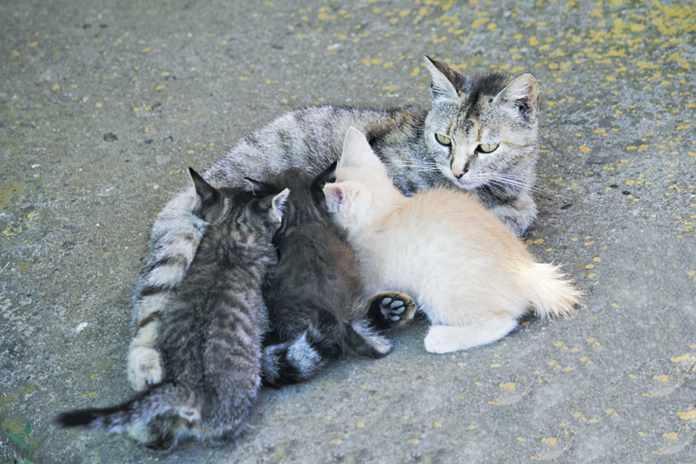Breeders, people who have taken in a stray who has not been spayed, and those who tend to feral cat colonies may all find themselves looking after a pregnant cat. Here’s what to know.
- A normal cat pregnancy generally lasts 63 to 65 days but can be as short as 57 days and as long as 70. (Essentially, we’re talking 9 weeks rather than 9 months, as for people.)
- A pregnant cat can experience morning sickness.
- You probably won’t notice for the first few weeks. The only outward sign tends to be a “pinking-up” of the nipples. They might become more visible, too. As soon as you realize your cat’s pregnant state, start feeding a food whose label states that it meets the guidelines of the Association of American of Feed Control Officials (AAFCO) for “pregnancy and lactation.”
- By the last couple of weeks of the pregnancy, the cat’s appetite will very possibly have almost doubled. At around this time it is advisable to see your veterinarian for an abdominal x-ray. This will both confirm that your cat is pregnant and provide a count of the number of kittens to expect once labor begins.
- As she gets within days of delivering, she will display nesting behavior. That means she will begin looking for a suitable place to give birth. Many pregnant cats prefer to deliver in a warm, dark, quiet place in the house. You can help by preparing a nesting box with a soft blanket or towels on the bottom.
- Cats often become very affectionate, even clingy, before labor and need your attention. Give her the closeness and gestures of love she craves. What contributes to emotional health can also contribute to physical health.
- Twenty-four to 48 hours before labor begins, many pregnant cats become very restless and also quite vocal, meowing and crying out more than usual. Appetite will markedly diminish, too.
- At birth, each kitten will weigh about 3 1/2 ounces. (A cat gains 2 to 4 pounds during pregnancy, but even just that small amount of extra weight will make her look pregnant.)
- Most cat births go off without a hitch, although the International Cat Care Association points to research that suggests between 7 and 10 percent of cats with “extremes of conformation” (body shape) such as Siamese and Persians experience difficult deliveries. Only about 2 percent of cats in general are believed to have problems during the birthing process.
The new mother will lick and nibble each amniotic sac to free her kittens. She will also bite through the umbilical cord, eat each kitten’s placenta, and use her tongue to clean the kittens and stimulate them to breathe. Healthy cats make their own best midwives.
Newborn Kittens
Newborn kittens cannot react to cold by shivering and therefore cannot maintain their own body temperature. They stay warm through direct body contact with their mother, and the heat is better conserved if they are snug in a kittening bed that has
been prepared for them.
been prepared for them.




